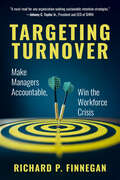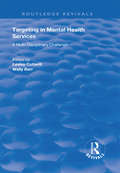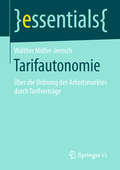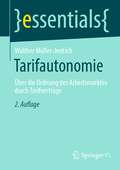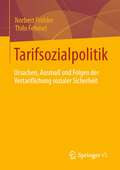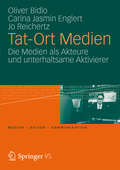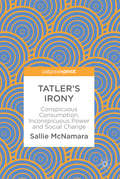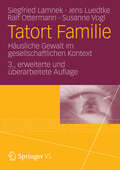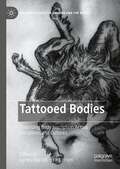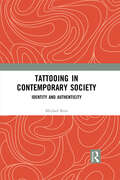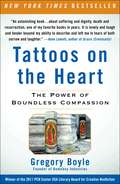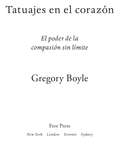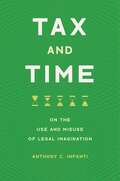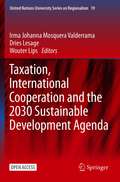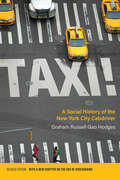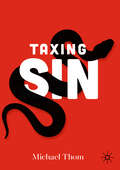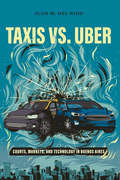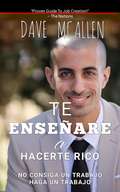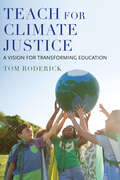- Table View
- List View
Targeting Social Transfers to the Poor in Mexico
by David Coady Susan ParkerA report from the International Monetary Fund.
Targeting Turnover: Make Managers Accountable, Win the Workforce Crisis
by Richard P. FinneganThe workforce crisis is here—and retaining your best employees is no longer optional.In Targeting Turnover, Dick Finnegan draws on decades of experience and groundbreaking data to reveal a stark truth: the US is running out of workers. As baby boomers retire and birthrates fall, the only sustainable path forward is to keep the good employees you already have.This book offers a proven, research-backed strategy for doing just that—by building trust between employees and their immediate supervisors.Forget one-size-fits-all solutions like pay and perks. The top predictor of retention and engagement is whether employees trust their boss. Yet most first-line leaders have never been trained—or held accountable—for building that trust.Finnegan delivers a call to action: make employee retention an executive-driven priority and equip your leaders to lead differently.You will learn how to do the following:Use stay interviews and practical tools to reduce turnoverHold managers accountable for engagement and retentionUnderstand the real costs of attrition—and how to reverse themApply forecasting and metrics to drive leadership behaviorAt a time when there are fewer workers and more complex employee needs, Targeting Turnover gives leaders the tools to stabilize teams, improve performance, and face the workforce future with confidence.
Targeting in Mental Health Services: A Multi-disciplinary Challenge
by Lesley Cotterill Wally BarrThis title was first published in 2000: This work has its origins in a three-year research project initially entitled, "Do SEMI Registers Make a Difference?" and known, for short, as the SEMI Register Project. The research project was designed to monitor and evaluate the introduction of registers for people with severe and enduring mental illness (SEMI) in general practices across the Wirral. In the context of this discussion, and within the framework of the mental health and social care reforms currently being introduced, key issues in the targeting agenda include: definitional issues surrounding the term "SEMI"; practical and methodological concerns about how people with SEMI are to be identified and targeted; interface issues relating to multi-disciplinary working between primary and secondary care; issues concerning the evidence-base for risk management policies and strategies; the role of training in effective targeting; reflection on the potential consequences of targeting policies and initiatives; and the meaningful involvement of service users from all sections of society.
Tarifautonomie: Über die Ordnung des Arbeitsmarktes durch Tarifverträge (essentials)
by Walther Müller-JentschIn diesem essential wird die demokratische Institution der Tarifautonomie dargestellt. Die für das Gemeinwesen wichtigste Leistung der Tarifautonomie liegt in ihrer den Arbeitsmarkt ordnenden, friedensstiftenden Funktion. Diese erzielt sie durch Kompromissbildung zwischen und Konfliktlösung von gegensätzlichen Interessen mittels paritätischer Vereinbarungen zwischen Gewerkschaften und Arbeitgeber(verbänden). Daneben erfüllt sie eine Reihe von essentiellen Funktionen: Schutz-, Verteilungs- und Partizipationsfunktionen für die Arbeitnehmer; Kartell-, Ordnungs- und Befriedungsfunktionen für die Arbeitgeber; Entlastungs- und Legitimationsfunktionen für den Staat. Aktuelle Probleme der Tarifautonomie ergeben sich aus der sinkenden Tendenz der Tarifbindung, der Verlagerung von Tarifkompetenzen auf die Betriebsebene sowie aus der Tarifkonkurrenz durch Spartengewerkschaften im Gesundheits- und Transportsektor.
Tarifautonomie: Über die Ordnung des Arbeitsmarktes durch Tarifverträge (essentials)
by Walther Müller-JentschIn diesem essential wird die demokratische Institution der Tarifautonomie dargestellt. Die für das Gemeinwesen wichtigste Leistung der Tarifautonomie liegt in ihrer den Arbeitsmarkt ordnenden, friedensstiftenden Funktion. Diese erzielt sie durch Kompromissbildung zwischen und Konfliktlösung von gegensätzlichen Interessen mittels paritätischer Vereinbarungen zwischen Gewerkschaften und Arbeitgeber(verbänden). Daneben erfüllt sie eine Reihe von essentiellen Funktionen. Schutz-, Verteilungs- und Partizipationsfunktionen für die Arbeitnehmer; Kartell-, Ordnungs- und Befriedungsfunktionen für die Arbeitgeber; Entlastungs- und Legitimationsfunktionen für den Staat. Die aktualisierte und wesentlich erweiterte 2. Auflage enthält u.a. ein neues Kapitel über den Stellenwert der Tarifautonomie im Rahmen der Sozialen Marktwirtschaft.
Tarifsozialpolitik: Ursachen, Ausmaß und Folgen der Vertariflichung sozialer Sicherheit
by Thilo Fehmel Norbert FröhlerDie anhaltende Transformation des Sozialstaats ist mit einer Bedeutungszunahme tarifvertraglicher Regulierung von sozialer Sicherung verbunden. Der Band bietet erstmals einen umfassenden Überblick über den Stand und die Entwicklung tariflicher Sozialpolitik. Als Bestandsaufnahme enthält er umfangreiche und die zeitliche Entwicklung nachzeichnende Darstellungen für die Alterssicherungs-, Arbeitsmarkt-, Gesundheits- und Familienpolitik in verschiedenen Branchen. Die Untersuchung fragt zudem nach den grundsätzlichen Wahrnehmungen, Einschätzungen und Bewertungen der Tarifvertragsparteien hinsichtlich der Verlagerung sozialpolitischer Verantwortung auf das System der industriellen Beziehungen. Neben Branchen und sozialpolitischen Feldern vergleicht die Studie auch Institutionensysteme. Obwohl mit Deutschland und Österreich zwei institutionell sehr ähnliche Distributionsregimes gegenübergestellt werden, finden sich erhebliche Unterschiede zwischen den beiden Ländern sowohl in Hinblick auf den Vertariflichungsgrad als auch auf die Sichtweisen von Arbeitgeberverbänden und Gewerkschaften. Im Ergebnis zeigt sich: Die Möglichkeiten der Tarifpolitik, eine den Interessen der Beschäftigten angemessene soziale Sicherung zu organisieren, hängen ab von den Rahmungen des Gesetzgebers: Auch bei zunehmend vertariflichter sozialer Sicherheit bleibt der Sozialstaat in sozialpolitischer Verantwortung.
Taste, Consumption and Markets: An Interdisciplinary Volume (Routledge Interpretive Marketing Research)
by Jonathan Bean Zeynep ArselTaste is a core concept for the social sciences and an orienting notion in everyday practice. It is of equal relevance to academics and laypeople alike. Theorizations of taste are frequently multi- disciplinary, bringing an opportunity to cross-fertilize ideas and concepts. At the same time, a reader, challenged by the diverse body and dispersed nature of theories on taste, needs guidance navigating the literature and framing areas of interest. Until now, those interested in an academic perspective on the concept have had to traverse a wide range of literature. This is the first book that assembles a range of writings on taste from across disciplines to provide the reader with a sense of the emerging and expanding boundaries of this field of study. Taste, Consumption and Markets offers a comprehensive and up-to-date review of taste, with an emphasis on how taste shapes boundaries, subcultures, and global culture, complemented by an introduction that provides a scaffold for the reader and a concluding section that reflects on the past, present, and future of research on taste. It shows the latest state of knowledge on the topic and will be of interest to students at an advanced level, academics, and reflective practitioners. It addresses the topics with regard to the sociology of taste and consumption and will be of interest to researchers, academics, and students in the fields of consumer studies, consumption ethics, sociological perspectives on consumption, and cultural studies.
Tat-Ort Medien
by Oliver Bidlo Carina Jasmin Englert Jo ReichertzDer Alltag menschlichen Zusammenlebens in modernen (nicht nur) westlichen Gesellschaften ist durch eine tiefgreifende und umfassende Mediatisierung gekennzeichnet: Medien spielen bei der kommunikativen Konstruktion von Wirklichkeit eine immer gewichtigere Rolle - vor allem dadurch, dass sie neben den Kommunikationsinhalten auch die Kommunikationsformen und das kommunikative und gesellschaftliche Handeln maßgeblich beeinflussen. Medien werden auch im Bereich der Inneren Sicherheit zunehmend eigenständige Akteure, die auf die Sicherheit ihrer Kunden achten und in deren Interesse selbst aktiv werden. Medien werden darüber hinaus auch Aktivierer, die ihre Kunden unterhaltsam dazu anhalten, sich regelkonform selbst zu führen oder aber sich in Maßen an der ,Arbeit' der Medien selbst zu beteiligen. Wir sind Zeitzeugen einer tief greifenden Mediatisierung der Sicherheitspolitik.
Tatler's Irony: Conspicuous Consumption, Inconspicuous Power And Social Change
by Sallie McNamaraThis book discusses Tatler, a monthly glossy magazine aimed at the wealthiest groups in British society, to consider how it addresses social change. The volume addresses specifically the period from 1997, the year New Labour was elected under Tony Blair, up to 2010, when the Conservative party and David Cameron came in to power. Sallie McNamara scrutinizes how the magazine negotiates ideas of ‘Britishness’, class, gender and national identity in a changing social, political, economic and cultural climate. Additionally, she explores the magazine’s humorous approach, and looks at how that distinctive address can potentially lead to misinterpretation. The British class system has seen many challenges over the period of the magazine’s history, and this study expertly grapples with exactly how Tatler has maintained its audience in a continually changing social environment.
Tatort Familie
by Siegfried Lamnek Ralf Ottermann Susanne Vogl Jens LuedtkeDen Gegenstand des Buchs bilden physische, psychische und sexuelle Formen häuslicher Gewalt gegen Kinder und Eltern, Frauen und Männer. Es stehen dabei die gesellschaftliche Problematisierungsgeschichte und die differenziellen Reaktionen auf unterschiedliche Formen häuslicher Gewalt im Vordergrund, werden der soziokulturelle bzw. sozialhistorische Kontext der Thematisierung und Problematisierung gewaltförmigen Verhaltens in intimen bzw. verwandtschaftlichen Beziehungen in die Analyse und Erklärung des Phänomens mit einbezogen und durch Ergebniss auch eigener Untersuchungen ergänzt.
Tattooed Bodies: Theorizing Body Inscription Across Disciplines and Cultures (Palgrave Studies in Fashion and the Body)
by James Martell Erik LarsenThe essays collected in Tattooed Bodies draw on a range of theoretical paradigms and empirical knowledge to investigate tattoos, tattooing, and our complex relations with marks on skin. Engaging with diverse disciplinary perspectives in art history, continental philosophy, media studies, psychoanalysis, critical theory, literary studies, biopolitics, and cultural anthropology, the volume reflects the sheer diversity of meanings attributed to tattoos throughout history and across cultures. Essays explore conceptualizations of tattoos and tattooing in Derrida, Deleuze and Guattari, Lacan, Agamben, and Jean-Luc Nancy, while utilizing theoretical perspectives to interpret tattoos in literary works by Melville, Beckett, Kafka, Genet, and Jeff VanderMeer, among others. Tattooed Bodies prompts readers to explore a few significant questions: Are tattoos unique phenomena or an art medium in need of special theoretical exploration? If so, what conceptual paradigms and theories might best shape our understanding of tattoos and their complex ubiquity in world cultures and histories?
Tattooing in Contemporary Society: Identity and Authenticity
by Michael ReesTattooing has become an increasingly popular phenomenon in the twenty first century, with growing numbers of sports stars and celebrities choosing to go ‘under the needle’ and tattooing regularly featuring in mainstream media. Based on interviews and participant observation at tattoo studios and tattoo conventions, this book investigates the reasons why so many people choose this form of body modification among all the options available to construct their identity. Drawing on Norbert Elias’ figurational sociology, the author considers the importance of the desire to create community with others and to claim an authentic identity among the various reasons for choosing to be tattooed. A study of the connection between body and identity, richly illustrated with empirical material, this book will appeal to sociologists and scholars of cultural studies.
Tattoos on the Heart: The Power of Boundless Compassion
by Gregory Boyle&“Destined to become a classic of both urban reportage and contemporary spirituality&” (Los Angeles Times)—Tattoos on the Heart is a series of parables about kinship and redemption from pastor, activist, and renowned speaker, Father Gregory Boyle.For twenty years, Father Gregory Boyle has run Homeboy Industries, a gang-intervention program located in the Boyle Heights neighborhood of Los Angeles—also known as the gang capital of the world. In Tattoos on the Heart, he has distilled his experience working in the ghetto into a breathtaking series of parables inspired by faith. From giant, tattooed Cesar, shopping at JC Penney fresh out of prison, you learn how to feel worthy of God’s love. From ten-year-old Pipi you learn the importance of being known and acknowledged. From Lulu you come to understand the kind of patience necessary to rescue someone from the dark—as Father Boyle phrases it, we can only shine a flashlight on a light switch in a darkened room. This is a motivating look at how to stay faithful in spite of failure, how to meet the world with a loving heart, and how to conquer shame with boundless, restorative love.
Tatuajes en el corazon
by Gregory Boyle¿Cómo luchar contra la desesperanza e interactuar con el mundo con un corazón bondadoso? ¿Cómo superar la vergüenza y tener fe a pesar del fracaso? Sin importar en dónde vivamos o cuáles sean nuestras circunstancias, todos necesitamos un amor ilimitado y restaurador. Magnífico y reconfortante, Tatuajes en el corazón demuestra ampliamente el impacto que puede tener el amor incondicional en nuestras vidas.En su condición de párroco que trabaja en el vecindario con la mayor concentración de actividad pandillera y criminal en Los Ángeles, Gregory Boyle ha creado una organización para ofrecer empleos, capacitación laboral y estímulos para que los jóvenes puedan trabajar juntos y aprender el respeto mutuo proveniente de la colaboración. Tatuajes en el corazón es una impresionante serie de parábolas producto de sus experiencias con personas del barrio durante las dos últimas décadas. Clasificados por temas y llenos de humor fresco y generosidad abundante, estos ensayos nos ofrecen una visión conmovedora sobre la forma tan plena en que podemos vivir nuestras vidas si encontramos la alegría en amar a los demás y en ser amados incondicionalmente. De César, el joven enorme y lleno de tatuajes haciendo compras en JCPenney recién salido de la prisión, aprendemos a sentirnos dignos del amor de Dios. De Lula, el chico de diez años, aprendemos la importancia de ser conocidos y aceptados. De Pedro, entendemos el tipo de paciencia necesaria para rescatar a alguien de la oscuridad. En cada capítulo recibimos el regalo de la sabiduría maravillosa y duramente lograda por Boyle. Estos ensayos eruditos, realistas y completamente alentadores que discurren sobre la hermandad y la redención, son ejemplos reconfortantes del poder que tiene el amor incondicional en los tiempos difíciles y de la importancia absoluta de luchar contra la desesperanza. Gracias a la orientación de Gregory Boyle, podemos reconocer nuestras propias heridas en las vidas fracturadas y en las luchas descomunales de los hombres y las mujeres que figuran en estas parábolas, para aprender a encontrar la alegría en todas las personas que hay a nuestro alrededor. Tatuajes en el corazón nos hace recordar que ninguna vida vale menos que otra.
Tax Fairness and Folk Justice
by Steven M. SheffrinWhy have Americans severely limited the estate and gift tax - ostensibly targeted at only the very wealthy - but greatly expanded the subsidies to low-wage workers through the Earned Income Tax Credit, now the single largest poverty program in the country? Why do people hate the property tax so much, yet seemingly revolt against it only during periods of economic change? Why are some groups of taxpayers more obedient to the tax authorities than others, even when they face the same enforcement regime? These puzzling questions all revolve around perceptions of tax fairness. Is the public simply inconsistent? A sympathetic and unified explanation for these attitudes is based on understanding the everyday psychology of fairness and how it comes to be applied in taxation. This book demonstrates how a serious consideration of "folk justice" can deepen our understanding of how tax systems actually function and how they can perhaps be reformed.
Tax Reform in Rural China
by Hiroki TakeuchiHow does China maintain authoritarian rule while it is committed to market-oriented economic reforms? This book analyzes this puzzle by offering a systematic analysis of the central-local governmental relationship in rural China, focusing on rural taxation and political participation. Drawing on in-depth interviews with Chinese local officials and villagers, and combining them with game-theoretic analyses, it argues that the central government uses local governments as a target of blame for the problems that the central government has actually created. The most recent rural tax reforms, which began in 2000, were a conscious trade-off between fiscal crises and rural instability. For the central government, local fiscal crises and the lack of public goods in agricultural areas were less serious concerns than the heavy financial burdens imposed on farmers and the rural unrest that the predatory extractive behavior of local governments had generated in the 1990s, which threatened both economic reforms and authoritarian rule.
Tax Reforms, "Free Lunches", and "Cheap Lunches" in Open Economies
by Giovanni Ganelli Juha TervalaA report from the International Monetary Fund.
Tax and Time: On the Use and Misuse of Legal Imagination
by Anthony C. InfantiHow tax law perpetuates injustice but might instead be used as a powerful force for creating a more just and equitable society The relationship between tax law and society, Anthony C. Infanti asserts, is too often overlooked by those who work outside of the field of fiscal policy. Yet, the way a country collects and spends its revenue can be viewed as a quantifiable reflection of how a country sees itself, sending messages about both what it values now and what it aspires to be in the future.Tax and Time sheds light on two of the most misunderstood universal human experiences: time and taxes. Anthony C. Infanti asserts that time in tax law is the product of pure imagination and calls into question the world beyond time that we have created for ourselves. Written with clarity and powerful insight, Tax and Time demonstrates how the tax laws have been used to imaginatively manipulate time in ways that perpetuate economic and social injustice. With its social justice focus, the book brings a sorely needed critical perspective to technical tax policy discussions. Infanti calls for a systematic reexamination and reworking of the relationship between time and tax law, asserting that the power of the legal imagination to manipulate time in tax law can both correct past injustices and help us to envision—and actually work toward—a better and more just society.
Taxation and the Household Saving Rate: Evidence from OECD Countries
by Vito Tanzi Howell H. ZeeA report from the International Monetary Fund.
Taxation, International Cooperation and the 2030 Sustainable Development Agenda (United Nations University Series on Regionalism #19)
by Dries Lesage Irma Johanna Mosquera Valderrama Wouter LipsThis open access volume addresses the link between international taxation, the 2030 Sustainable Development Agenda and the medium-term revenue strategy concept. It also analyses how countries and governments can reinforce this link in current and future initiatives in international taxation, including the base erosion profit shifting project initiated by the Organization for Economic Co-operation and Development with the political mandate of the G20. It discusses the 2030 Sustainable Development Agenda that are relevant for taxation and assesses the current work done by international organizations, regional tax organizations and countries to achieve these Sustainable Development Goals. The contributions to this volume provide an interdisciplinary mix of expertise in tax law, international political economy, global governance and international relations. Through these different perspectives, this volume provides an elaborate reference and evaluation framework for multilateral cooperation on tax and development to strengthen the revenue system of developed and developing countries. This topical volume is of interest to students and researchers of the social sciences, law and economics, as well as policy makers working on taxation.
Taxi!: A Social History of the New York City Cabdriver
by Graham Russell HodgesWhy the cabdriver is the real victim of the false promises of Uber and the gig economy.2007 Noteworthy Book in Industrial Relations and Labor Economics, Princeton University Industrial Relations SectionHailed in its first edition as a classic study of New York City's history and people, Graham Russell Gao Hodges's Taxi! is a remarkable evocation of the forgotten history of the taxi driver. This deftly woven narrative captures the spirit of New York City cabdrivers and their hardscrabble struggle to capture a piece of the American dream. From labor unrest and racial strife to ruthless competition and political machinations, Hodges recounts this history through contemporary news accounts, Hollywood films, and the words of the cabbies themselves. A new preface recalls the author's five years of hacking in New York City in the early 1970s, and a new concluding chapter explores the rise of app-based ridesharing services with the arrival of companies like Uber and Lyft. Sharply criticizing the use of the independent contractor model that is the cornerstone of Uber and the gig economy, Hodges argues that the explosion of for-hire vehicles in Manhattan reversed decades of environmental anti-congestion efforts. He calls for a return to the careful regulations that governed taxicabs for decades and provided a modest yet secure living for cabbies. Whether or not you've ever hailed a cab on Broadway, Taxi! provides a fascinating perspective on New York's most colorful emissaries.
Taxing Sin
by Michael ThomConventional wisdom dictates that those goods which are said to cause harm or impose costs on society deserve a special tax. For centuries, governments have levied these "sin taxes" on alcohol and tobacco, but the list of taxable sins has now grown to include soda and marijuana, with calls to impose further taxes on plastic bags, meat, and even robots and carbon. Contrary to what experts and policymakers tell us, many of these alleged sins impose very little, if any, cost on society, and the harms that do exist can be minimized without resorting to tax. What follows in this book is a discussion of four case studies—on tobacco, marijuana, alcohol and soda—which make the case against the conventional wisdom in taxing these "sins", before concluding that when it comes to taxing sin, it is time for governments to forgive—and forget.
Taxis vs. Uber: Courts, Markets, and Technology in Buenos Aires
by Juan Manuel del NidoUber's April 2016 launch in Buenos Aires plunged the Argentine capital into a frenzied hysteria that engulfed courts of law, taxi drivers, bureaucrats, the press, the general public, and Argentina's president himself. Economist and anthropologist Juan M. del Nido, who had arrived in the city six months earlier to research the taxi industry, suddenly found himself documenting the unprecedented upheaval in real time. Taxis vs. Uber examines the ensuing conflict from the perspective of the city's globalist, culturally liberal middle class, showing how notions like monopoly, efficiency, innovation, competition, and freedom fueled claims that were often exaggerated, inconsistent, unverifiable, or plainly false, but that shaped the experience of the conflict such that taxi drivers' stakes in it were no longer merely disputed but progressively written off, pathologized, and explained away. This first book-length study of the lead-up to and immediate aftermath of the arrival of a major platform economy to a metropolitan capital considers how the clash between Uber and the traditional taxi industry played out in courtrooms, in the press, and on the street. Looking to court cases, the politics of taxi licenses, social media campaigns, telecommunications infrastructure, public protests, and Uber's own promotional materials, del Nido examines the emergence of "post-political reasoning": an increasingly common way in which societies neutralize disagreement, shaping how we understand what we can even legitimately argue about and how.
Te enseñaré a hacerte rico: No consiga un trabajo Haga un trabajo
by Dave McAllemLa gente no da lo que no tiene. Dave McAllen tiene trabajos. A los que escuchan, les da trabajo. Gana mucho dinero después de investigar las frustraciones y dolores más profundos de las personas y crear productos especiales que están sin explotar para ayudarlos a encontrar respuestas y soluciones. Entonces, si estás aquí, seguro que conseguirás el trabajo de tus sueños. Él le mostrará exactamente cómo gana miles cada semana con estos productos, en su conciencia de riqueza. Te enseñaré a hacerte rico, es un libro sobre los secretos de la riqueza de los exitosos y cómo aprovecharlos. Dave presenta a los lectores una guía práctica y probada para orientar los ingresos bajo demanda a nivel mundial, 24 horas al día, 7 días a la semana. Él le enseñará cómo hacer estos productos que aportan ese dinero y hacen su propio trabajo. Con esto, no buscará 50 formas de conseguir un trabajo. Esta es una garantía de trabajo.
Teach for Climate Justice: A Vision for Transforming Education
by Tom RoderickA proactive, inclusive plan for the cross-disciplinary teaching of climate change from preschool to high school. In Teach for Climate Justice, accomplished educator and social and emotional learning expert Tom Roderick proposes a visionary interdisciplinary and intersectional approach to PreK–12 climate education. He argues that meaningful instruction on this urgent issue of our time must focus on climate justice—the convergence of climate change and social justice—in a way that is emotionally safe, developmentally appropriate, and ultimately empowering. Drawing on examples of real-life educators teaching climate change, Roderick identifies eight key dimensions of climate education that will prepare students to face the challenges of the climate crisis and give them the means to take action. These dimensions include not only educating for a deep understanding of the scientific, geopolitical, and socioeconomic equity issues that surround global warming, but also cultivating appreciation for the environment, building a supportive community, and fostering active hope for the future. Roderick's intentional layering of skills will help students develop the knowledge and sense of agency necessary to engage in civil resistance and nonviolent activism. In support of this crucial endeavor, Roderick suggests evidence-based teaching strategies, practices that promote inclusivity, and tools for social and emotional learning. This timely and uplifting book lays out a powerful vision for teaching, learning, and curriculum development to nurture a generation of courageous, informed advocates for climate justice.

